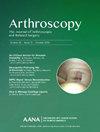Females Have Higher Return-to-Sport Rate Than Males Among Collegiate Athletes After Hip Arthroscopy for Femoroacetabular Impingement Due to the Difference in the Type of Sports, Type of Impingement, and Prevalence of Severe Cartilage Damage
IF 5.4
1区 医学
Q1 ORTHOPEDICS
Arthroscopy-The Journal of Arthroscopic and Related Surgery
Pub Date : 2024-10-21
DOI:10.1016/j.arthro.2024.10.016
引用次数: 0
Abstract
Purpose
To investigate the return to sport (RTS) rate and the sex-based difference of collegiate athletes after arthroscopic treatment for femoroacetabular impingement (FAI).
Methods
Patients who were collegiate athletes at the time of surgery and underwent hip arthroscopy for treatment of FAI between January 2009 and June 2020 were included. Patients were excluded if they were in their final year of eligibility, graduated, retired, or had plans to retire from collegiate play before surgery. Publicly available data were collected regarding each patient’s collegiate team and division and RTS status after surgery. Comparisons were made based on the RTS status and gender.
Results
Of the 181 hips (144 athletes) who met the inclusion criteria, 114 were male (63%) and 67 were female (37%), with a median age of 20.4 (range: 18.0-24.5). Eighty-six percent (155 hips) returned to sport at the collegiate level after hip arthroscopy. Males were significantly less likely to return to sport compared with females (82% vs 93%, odds ratio = 2.8, 95% confidence interval: 1.003-7.819, P = .042). Males participated in more contact sports (26% vs 1.5%, P < .001) and had more mixed-type FAI (95.6% vs 80.6%, P = .003) compared with females. In addition, males had more grade 3/4 chondral defects (28% vs 13%, P = .023) and underwent microfracture more frequently (11% vs 3%, P = .047). Further, males had significantly larger postoperative alpha angles (46.2 vs 43.6, P < .001).
Conclusions
Collegiate athletes were found to have a high RTS rate of 86% after arthroscopy for the treatment of FAI; however, males were less likely to RTS compared with females. Sex-based differences were identified in the type of sports, type of FAI, prevalence of severe cartilage damage, and postoperative alpha angle.
Level of Evidence
Level IV, retrospective case series.
在接受髋关节镜手术治疗股骨髋臼撞击症的大学生运动员中,由于运动类型、撞击类型和严重软骨损伤发生率的不同,女性恢复运动的比例高于男性。
目的:研究大学运动员在接受关节镜治疗 FAI 后的运动恢复率(RTS)和性别差异:方法:纳入2009年1月至2020年6月期间接受髋关节镜治疗FAI手术的大学生运动员。如果患者在手术前处于资格赛的最后一年、已毕业、已退役或已计划退役,则排除在外。我们收集了有关每位患者所在大学球队和分区以及术后RTS状况的公开数据。根据RTS状态和性别进行比较:在符合纳入标准的 181 个髋关节(144 名运动员)中,男性 114 个(占 63%),女性 67 个(占 37%),年龄中位数为 20.4 岁(范围:18.0-24.5 岁)。髋关节镜手术后,86% 的运动员(155 髋关节)重返大学体育运动。与女性相比,男性重返运动场的可能性明显较低(82% vs 93%,OR = 2.8,95% CI [1.003,7.819],P=0.042)。与女性相比,男性参加接触性运动的比例更高(26% vs 1.5%,P < 0.001),混合型FAI的比例更高(95.6% vs 80.6%,P=0.003)。此外,男性患有3/4级软骨缺损的比例更高(28% vs 13%,P=0.023),接受微骨折的比例更高(11% vs 3%,P=0.047)。此外,男性的术后α角明显更大(46.2 vs 43.6,p< .001):结论:研究发现,大学运动员在接受关节镜手术治疗FAI后重返运动场的比例高达86%,但与女性相比,男性重返运动场的可能性较低。在运动类型、FAI类型、严重软骨损伤发生率和术后α角等方面发现了性别差异:回顾性病例系列,IV级。
本文章由计算机程序翻译,如有差异,请以英文原文为准。
求助全文
约1分钟内获得全文
求助全文
来源期刊
CiteScore
9.30
自引率
17.00%
发文量
555
审稿时长
58 days
期刊介绍:
Nowhere is minimally invasive surgery explained better than in Arthroscopy, the leading peer-reviewed journal in the field. Every issue enables you to put into perspective the usefulness of the various emerging arthroscopic techniques. The advantages and disadvantages of these methods -- along with their applications in various situations -- are discussed in relation to their efficiency, efficacy and cost benefit. As a special incentive, paid subscribers also receive access to the journal expanded website.

 求助内容:
求助内容: 应助结果提醒方式:
应助结果提醒方式:


